Kayaking is a great way to stay in shape and have fun and travel to otherwise non-accessible distant places you can explore with friends or by yourself. All watersports come with their own dangers and challenges to face, and kayaking is no different. But, are Kayaks dangerous? Learning to overcome those challenges that can arise will give you a much better and safer experience when Kayaking.
Can Kayaking Be Dangerous?
In truth, Kayaks can be dangerous, even deadly for those who don’t know how to use them properly and dont take simple precautions when out paddling. It is important that you only attempt to kayak in waters that match your skill level. However, even when paddling in calm waters, there are dangers that can arise unexpectedly. Being prepared and forewarned is key if you want to enjoy kayaking safely.
What Can I Do To Stay Safe When Kayaking?
- Wear a kayak specific life jacket or PFD
- Know how to swim & float
- Learn and practice how to Eskimo roll
- Paddle in pairs or groups
- Plan a safe launch and recovery site
- Understand the waterway you are going to be paddling on
- Let someone know you are going kayaking and what time you will be back.
- Consider filing a float plan with the authorities.
When A Helping Hand Isn’t An Option
Out on the water, help is not always near and at times not an option at all for some, so it’s important to know the dangers of kayaking ahead of time and to take precautionary measures to stay safe out on the water. By knowing the possible dangers and planning for them, it can bring you peace of mind and give you confidence for a more pleasurable kayaking experience.
Kayaking By Yourself, Is It Safe?
Kayaking by yourself is certainly less safe when compared to kayaking with a partner or in a group, however, this doesn’t mean that you need to stay onshore if all of your friends are busy this weekend. You can go kayaking by yourself, and many people do. However, it requires taking extra precautions and knowing how to get yourself out of sticky situations, should they arise. If you are a beginner kayaker, I would suggest sticking with a friend until you have more experience. Whitewater kayaking on the other hand should always be done with someone to watch your back.
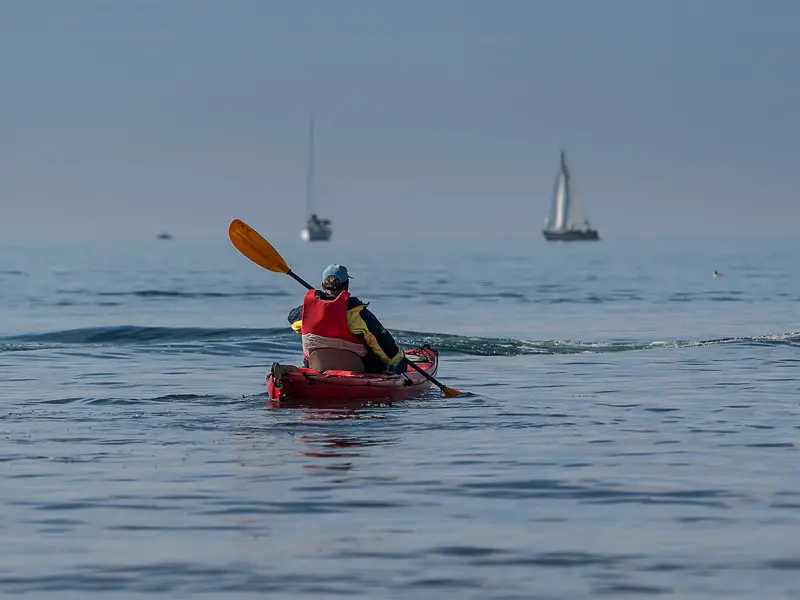
Is Kayaking Safe For Non-Swimmers?
It can be if you know what you’re doing, but it is preferable to know how to swim. Not being able to swim doesn’t need to exclude you from kayaking, it is however always going to carry its own challenges. Just using the life jacket and hoping you’ll float to shore or safety isn’t the best plan.
Unless you have completely mastered in-water reentry, a good rule for any kayaker is to only paddle as far from shore as you can swim. If you can’t swim very far, then it is best to stick along the shoreline.
Sticking to shallow water isn’t without danger, some of the shallowest streams or creeks that you can walk through can also have the swiftest currents and the slickest rocks. It is never a safe decision to do anything water related by yourself without knowing the basics of floating and swimming first. Your safety and the safety of others could depend upon it.
10 Kayak Safety Measures Every Kayaker Should Know
Here are some super important safety measures to take while planning your trip in a kayak. Each of them necessary and able to give you a better chance of making it through if something were to go wrong.
- Wear the proper clothing for getting wet in, also dress warm or cold for the type of weather you’ll be traveling in. (Make allowances for shifts in the weather also, like a raincoat or an extra sweater for needed warmth later packed in waterproof material. Or a pair of water shoes for having to carry the kayak in low water when you bottom out.
- Be aware of the weather and any possible changes at all times. Heavy rain can cause flash floods and swollen rivers, strong winds can make paddling back to shore difficult and tiring, and heavy rain can reduce visibility and leave you disorientated. Check the weather before you go.
- Be aware of the water conditions you are going to be paddling in. Whether you chose a creek, river, lake, or the sea, know what currents/tides you are expecting as well as other possible hazards along your planned route.
- Always wear a Personal Floatation Device (Life Vest) that’s properly fitted and secured. Choose a kayak-specific PFD that allows good movement to paddle.
- Take enough water for the entire day even if leaving for just a couple of hours. You sweat a lot when kayaking and don’t want to get dehydrated. Drinking river water also isn’t a good idea and can make you sick.
- Make sure you have basic survival equipment and that it’s packed in a waterproof dry bag. Things such as lighters, food, sunscreen, first aid supplies, and a knife can come in handy even on a short trip.
- Travel in a group of two or more if you can. There’s safety in numbers.
- If you go kayaking by yourself then tell someone, and carry a Personal Locator Beacon (PLB), cell, or satellite phone. Make sure someone knows where you’re going and when you plan to be back so they know to come looking after a certain time if something goes wrong while you’re on your own.
- Try to hang onto your paddle in rough water. It could mean the difference between getting carried away downstream or making it to shore when needed. Your paddle should float if you drop it, but it may float at a different speed to your kayak.
- Learn to roll yourself and your kayak back over when it’s overturned upside down in the water. without leaving the boat to do it. Also known as a kayak sweep roll. It is also important that you know how to exit your kayak if you are unable to successfully roll it back over.
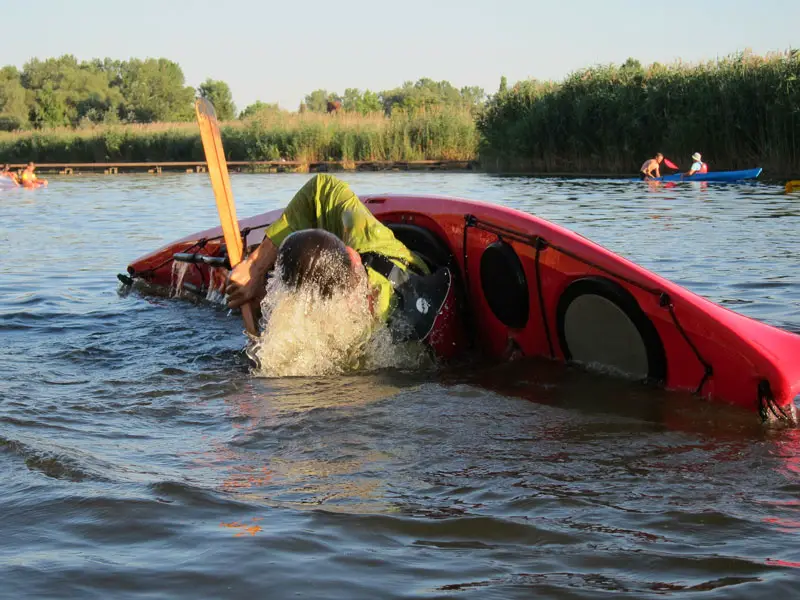
Cold Water
Kayaking on cold water adds an element of risk. Quick submersion into water 59°F (15°C) or below risks a condition known as cold water shock, where your blood vessels in the skin suddenly constrict. This can cause temporary difficulties moving your arms and legs, but more seriously can put a significant strain on your cardiovascular system. In some cases, cold water shock can be fatal to those with underlying heart conditions.
Spending an extended period of time in frigid water can cause the onset of hypothermia. Therefore, make sure that you dress appropriately for the conditions, with a thick wetsuit or drysuit.
Drinking And Kayaking
Most of us like to throw a few cold ones back while fishing and enjoying time out in the water. Drinking responsibly can enhance a fun afternoon but becoming inebriated while kayaking is not a good idea. Besides the legal consequences, alcohol affects your coordination and decision-making process. Balance is always an issue when paddling and casting a fishing line. When intoxicated that becomes a challenge but it’s still not as bad as tipping over in your boat and hitting your head on a rock.
Don’t underestimate the sun’s reflection off of the water. High heat and drinking do not mix. Alcohol is a diuretic, making you need to urinate more. This is somewhat inconvenient in a kayak, but also seriously increases your risk of becoming dehydrated.
Every sip you take increases the risk of something going wrong, the best advice is to avoid alcohol altogether when kayaking. Drinking and kayaking can be dangerous.
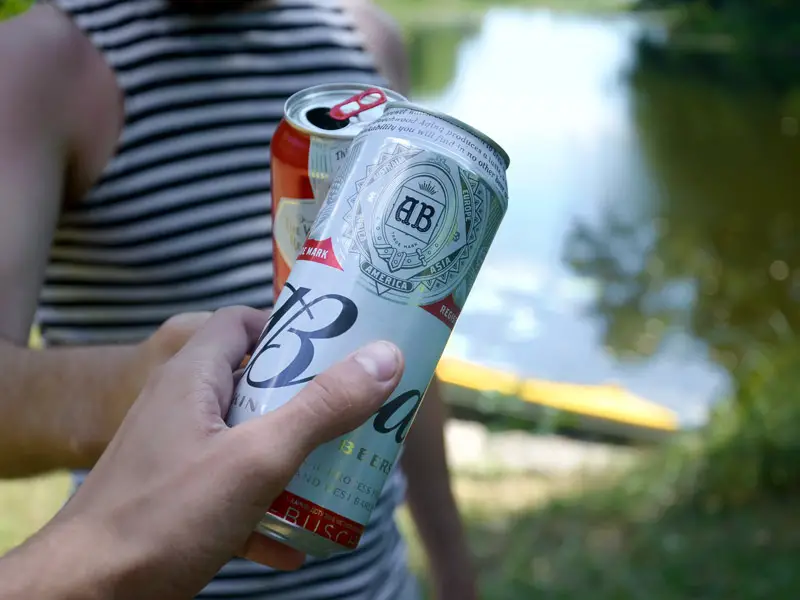
There are literally hundreds of accidents and deaths that occur each year that could have been avoided. Studies show that between 50% – 70% of unintentional drowning deaths may have involved alcohol as a factor. Waiting until you are safely onshore or at home before having a drink could literally save your life.
Fear And Panic
Fear and panic – can debilitate rational thought processing during an emergency situation, When seconds matter and every decision could mean life or death to someone it’s important to stay as calm as possible.
Getting into a blind panic puts more than just yourself in danger. A person in full panic mode, wildly thrashing around uncontrollably without reason, can easily capsize their buddy that is trying to rescue them, leaving both kayakers stranded without a boat and quickly changing a rescue situation into a survival one.
It is vital that you stay calm and don’t allow panic to take over. Before you venture out onto open waters, you should practice capsizing and falling into the water, and how to recover. This way, it wont come as much of a shock to you when it happens for real.
Taking steps to ensure you’re safe will also help the others around you to be better equipped if the need does arise to help you out of the water. Like bringing a floatation device or something as simple as an extra rope to hold onto while someone comes to your aide can help avert disaster.
Whitewater Kayaking
Whitewater kayaking is the sport where kayaks are ridden down fast flowing rivers. Rivers are graded between I – VI on the international scale of river difficulty, with class-I being the easiest and class-VI being “extreme”.
Whitewater is not the place to be learning the basics, and only to be attempted by more experienced paddlers, with a buddy or in a group. Even in the lower grade rivers, moving water can be deadly if you don’t know what you are doing. There is an ever-present risk of getting trapped in hydraulics or pinned against a rock or branch by the current. It is best for a trained professional to teach you how to read white-water before venturing out onto a fast-flowing river.
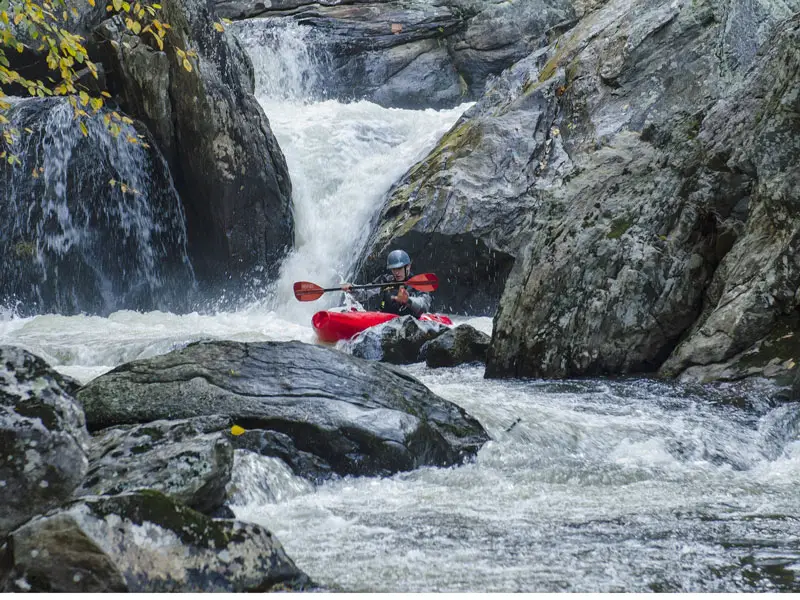
Sea Kayaking
If you’re out on the ocean there are things like tides and waves to worry about. Breaking surf can flip a kayak and smash you against the sea bed. Try to choose a launch and recovery point that avoids having to pass through the breakers. If you are unsure of the area, stop and talk with locals and check if there are any local danger spots that you should avoid. Don’t be afraid to ask local lifeguards authorities either, they have first-hand experience with knowing where the dangers may lie out on the water.
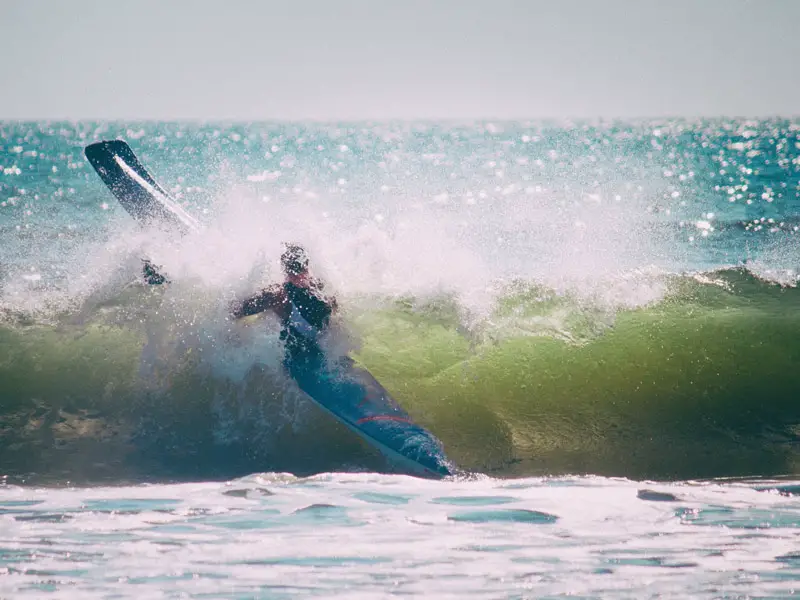
The ocean also has a way of dragging people and things out farther than they originally wanted to be. Check the tides before you go, and know what time they are going to change. Paddling into the tidal flow is like running on a tredmill, it tires you out while you fail to cover any distance towards your destination. So take proper measures to ensure your trip is well thought out by researching your next trip thoroughly and always following your local rules for whatever your county and state allow and do not allow.
Shallow Water Kayaking
Many beginner Kayakers choose to begin kayaking using places like creeks and rivers to get their feet wet and learn the basics of kayaking by trial and error. However, kayaking in shallow water is not without hazards either. Shallow water kayaking substantially increases the risk of hitting your head on something hard. Always wear a helmet when kayaking in water that is shallow. Being knocked unconscious in the water is a nightmare scenario.
Kayakers travelling in creeks and streams will also often have to stop and get out to pick the boat up and carry it along with them over shallow parts where your boat may bottom out. This is where the danger lies in getting hurt by slipping or tripping on a rock or branch.
Some of the shallowest creeks and streams can have the fastest currents and slickest rocks. Never underestimate the dangers that water can bring. Drowning is possible even in 2 inches of water. Especially if knocked unconscious.
Conclusion: Are Kayaks Dangerous?
Kayaks themselves are not dangerous, but the sport of kayaking has potential hazards and dangers that need consideration. Staying safe is as easy as knowing what the dangers are and taking proper measures to either avoid them or overcome them. To Kayak safely requires know-how and taking the cautionary steps to ensure a better outcome of survival should certain situations arise.
We hope this list has better informed you of the dangers so you can try to avoid any emergency while you kayak like a pro in no time at all. Remember to have a water exit strategy for getting out of the water safe and making it back to your ride as well, you don’t want to have to walk back miles to your vehicle carrying your Kayak the whole way. Now, go have fun. Adventure awaits!
